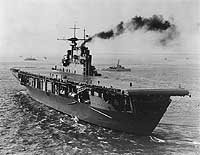One of the most daring missions ever conceived and executed was the Doolittle raid on Tokyo, April 18th, 1942. The volunteer crews were led by LT COL James H. Doolittle and launched from USS Hornet (CV-8). Imagine volunteering for a mission of extreme personal risk involving launching in a B-25 twin engine Army Air Corps bomber from an aircraft carrier, flying hundreds of miles over open ocean, bombing Japan, and then hopefully landing in China because you knew when you launched that you didn’t have enough fuel to make it home. If that alone doesn’t make you cringe, consider the following:
The B-25 was never designed to be flown off aircraft carriers.
WWII carriers were not equipped with catapults and all aircraft launched under their own power (known as a “deck run”).
The Hornet was tiny in comparison to today’s massive carriers.
The planned launch point was 400 nautical miles from Tokyo but detection by enemy picket boats forced an early launch in excess of 600nm out.
Here are some images courtesy of the National Archives and Naval Historical Center that really put this mission into perspective:
Guts and lots of ’em. Why, you ask, did we ever pursue such a foolish idea? To send a message. Given the small useful bomb load of a B-25 at such an extended range we had little hope of inflicting serious damage. Indeed the planners behind the mission knew this from the outset and the crews knew it when they launched. The war was not going our way in the Pacific and the prevailing thought was we needed to prove a point. We hit the proud nation of Japan squarely in the ego. We embarrassed them. Nothing like Pearl Harbor but we took the fight to them. The American public needed such a boost.
From the Naval Historical Center:
Most of the sixteen B-25s, each with a five-man crew, attacked the Tokyo area, with a few hitting Nagoya. Damage to the intended military targets was modest, and none of the planes reached the Chinese airfields (though all but a few of their crewmen survived). However, the Japanese high command was deeply embarrassed. Three of the eight American airmen they had captured were executed. Spurred by Combined Fleet commander Admiral Isoroku Yamamoto, they also resolved to eliminate the risk of any more such raids by the early destruction of America’s aircraft carriers, a decision that led them to disaster at the Battle of Midway a month and a half later.
Take a minute to think about what these men faced and were willing to sacrifice on behalf of their nation. Their heroic efforts played a large part in turning the war of the Pacific in our favor.
Here’s a listing of the crews:
And here’s the official Raiders site:




Comments on this entry are closed.